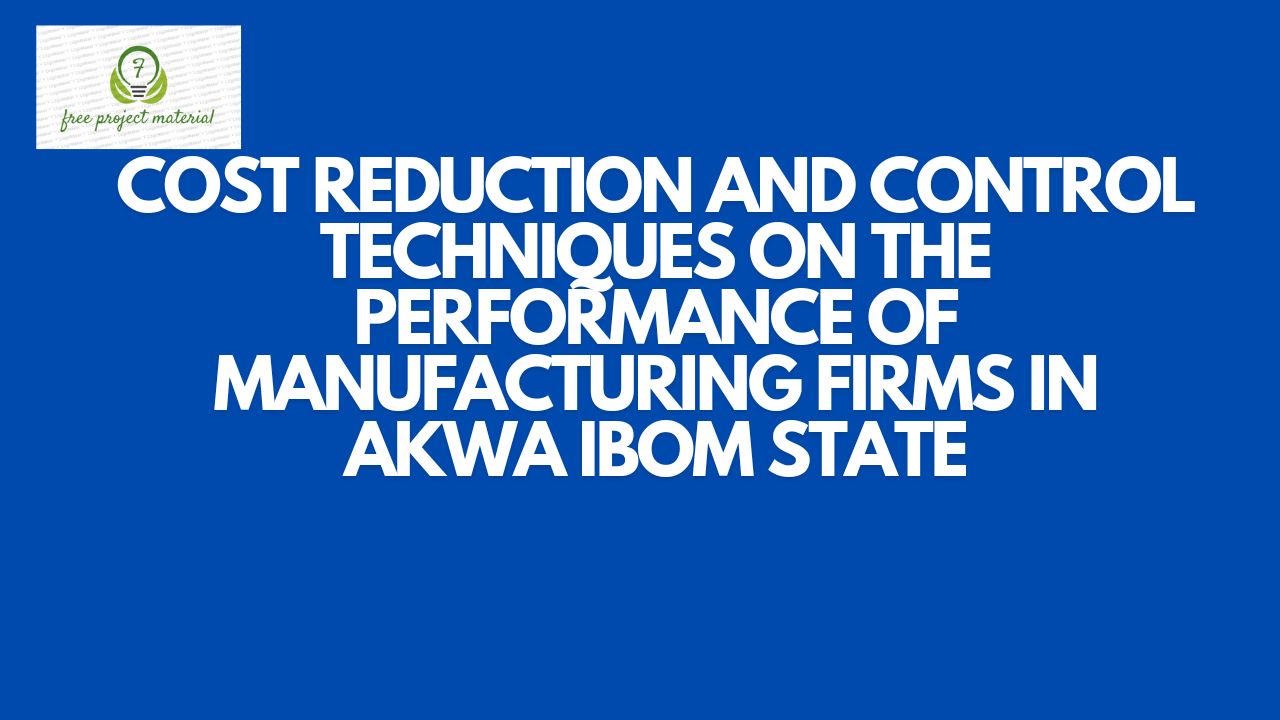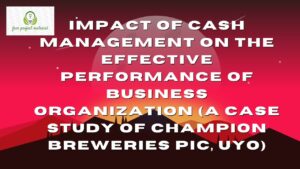ABSTRACT
This study examined the impact of cost reduction and control techniques on the performance of manufacturing firms in Akwa Ibom State (A case study of Arsan water and Siba Group of Companies). To accomplish the objectives of the study, the study adopted the survey research design while the Taro Yamane formula was used to determine a sample size of fifty-one (51) respondents from the study population of fify-eight (58). Instrument of the study was a self-developed questionnaire and the forms were personally administered. Research questions were formulated to guide the study and data were analyzed using the descriptive statistical tools which involved the use of simple percentages and frequency tables. Based on the data analysis, findings of the study revealed that; there is a significant effect of material control on the performance of manufacturing firm, there is a significant effect of market research on the performance of manufacturing firm, there is a significant effect of financial control on the performance of manufacturing firm, there is a significant effect of cost-benefit analysis on the performance of manufacturing firm. It was recommended that target and standard set should not be vague as this will be unrealistic in the course of achieving planned cost control in an organisation. For effective cost control to be achieved there should be proper data collection, data analysis and control administration.
LIST OF TABLES
Table 4.1.1: Responses to Research question one – – – 25
Table 4.1.2: Responses to Research Question Two – – – 26
Table 4.1.3: Responses to Research question Three – – – 27
Table 4.1.4: Responses to Research question four – – – 28
TABLE OF CONTENTS
Title page – – – – – – – – – i
Declaration – – – – – – – – – ii
Approval page – – – – – – – – iii
Certification – – – – – – – – iv
Dedication – – – – – – – – – v
Acknowledgement – – – – – – – vi
Abstract – – – – – – – – – vii
List of Tables – – – – – – – – viii
Table of Contents – – – – – – – – ix
CHAPTER ONE
INTRODUCTION
1.1 Background of the Study – – – – – – 1
1.2 Statement of the Problem – – – – – – 5
1.3 Objective of the study – – – – – – 6
1.4 Research Question – – – – – – – 7
1.5 Significance of the Study – – – – – – 8
1.6 Scope of the Study – – – – – – – 8
1.7 Limitations of the Study – – – – – – 9
1.8 Organization of the Study – – – – – – 9
1.9 Definition of Terms – – – – – – 10
CHAPTER TWO
REVIEW OF RELATED LITERATURE
2.1 Conceptual Framework – – – – – – 12
2.1.1 Concept/Meaning of Cost Reduction – – – – 12
2.1.2 Impact of Cost Structure on Profitability – – – 14
2.1.3 Effect of Material Control on the Performance of
Manufacturing Firm – – – – – – 15
2.1.4 Effect of Market Research on the Performance of
Manufacturing Firm – – – – – – 19
2.1.5 Effect of Finance Control on the Performance of
Manufacturing Firm – – – – – – 23
2.1.6 Effect of Cos-Benefit Analysis on the Performance of
Manufacturing – – – – – – – 27
2.17 Techniques for Cost Reduction – – – – – 31
2.1.8 Differences between Cost Control and Cost Reduction – 33
2.2 Theoretical Review – – – – – – – 34
2.2.1 Neo-classical Growth Theory – – – – – 34
2.2.2 Going Concern Theory – – – – – – 35
2.3 Empirical Framework – – – – – – 36
2.4 Gap in Literature – – – – – – – 41
CHAPTER THREE
RESEARCH DESIGN/ METHODOLOGY
3.1 Research Design – – – – – – – 42
3.2 Population of the Study – – – – – – 42
3.3 Sampling Size – – – – – – – 42
3.4 Instrumentation – – – – – – – 43
3.6 Method of Date Analysis – – – – – – 43
3.7 Problems of Data Collection – – – – – – 44
CHAPTER FOUR
DATA PRESENTATION ANALYSIS AND INTERPRETATION
4.1 Analysis of Research Questions – – – – – 45
4.1.1 Analysis of Research Question One – – – – 45
4.1.2 Analysis of Research Question Two – – – – 47
4.1.3 Analysis of Research Question Three – – – 49
4.1.4 Analysis of Research Question Four – – – – 51
4.2 Discussion of Findings – – – – – – 52
CHAPTER FIVE
SUMMARY, CONCLUSION AND RECOMMENDATION
5.1 Summary of Findings – – – – – – 55
5.2 Conclusion – – – – – – – – 55
5.3 Recommendations – – – – – – – 56
References
Appendix I
Appendix II
CHAPTER ONE
INTRODUCTION
1.1 Background of the Study
Cost reduction as the term used for planned and positive approach to the improvement of efficiency (Asaolu and Nassar, 2007). It can be viewed in many ways, such as increasing productivity, and elimination of waste. Lucey (1996) refers to cost reduction as a concept which has the aim of reducing cost from a previously accepted norm or standard without reducing the effectiveness or performance of the project or services.
The process of regulating the cost of operating a business is known as cost control. These limits are usually stated as standard cost or target cost limits in a formal operation plan or budget. Cost control is the process of avoiding wasteful use of valuable resources and encouraging efficiency and cost consciousness. Cost control is the practice of managing and/or reducing business expenses. Cost control starts by the business identifying what their cost are and evaluate whether those cost are reasonable and affordable, thereafter if necessary, they can look for ways to cut costs through methods such as cutting back, moving to a less expensive plan or changing services providers. To be profitable companies must not only earn revenues, but also control costs. If the costs are too high, profit margin will be low making it difficult for a company to succeed against its competitors. Brumbaug (2008) was of the opinion that companies should watch the cost and the profit will take of itself.
Cost control in an integral part of any Manufacturing firm. No firm will stay in the business if it does not employ prudent means of checking its costs by ensuring that they don’t over surpass the estimated costs projections. If costs are not checked properly the outcome can be negative to smooth running of the business. Hamilton and Martha (2007) opined that for cost control purpose a budget provides standard cost. Company management must match budgeted and actual costs and strive to ensure that they always remain within the estimated projections.
Its core objective is to maximize profits while minimizing cost. The assumption that the manufacturing industry like many other industry players have initiated cost control measures to ensure it operates in a cheaper and more efficient manner without compromising on quality service delivery is an ongoing debate. Therefore, costs must be controlled by all means possible to achieve the needed output and increase revenues.
The implication is that cost should be controlled rather than embarking on unscientific cost control that may translate to lowering the quality of service provision. Management is normally forced to adopt practices to regulate (control) rather than reducing cost. Cost increases as various production activities are embarked upon, the need to keep up cost in check arises because standards for production will be set and actual proportion will be made thereby bringing about variances which can only be reduced or eliminated through effective cost control. Sikka (2003) is of the opinion that cost control practices consist of methods, policies, procedures and systems that helps to regulate the cost of operating and ensure that cost do not go beyond a certain level. Some of these methods are:
Inventory management: In this strategy the inventory levels are effectively managed to avoid overstocking or understocking. By monitoring and controlling inventory, organizations can minimize carrying costs, reduce the risk of obsolete stock, and optimize cash flow.
Supplier management: This focuses on developing strong relationships with suppliers to negotiate favorable pricing, terms, and conditions. What’s more, effective supplier management also involves selecting reliable and cost-effective suppliers, maintaining clear communication, and fostering collaborative partnerships to drive cost savings and improve overall supply chain efficiency.
Process optimization: Process optimization aims to streamline operations, eliminate inefficiencies, and reduce costs. This is done by analyzing and improving workflows, identifying bottlenecks, automating repetitive tasks, and enhancing productivity through continuous improvement initiatives.
Waste reduction: The waste reduction strategy aims to minimize waste generation and maximize resource utilization. This is achieved by implementing recycling programs, optimizing production processes to minimize scrap or rework, and promoting sustainable practices.
Pricing strategies: Pricing strategies involve setting competitive prices that balance customer value and profitability. This may include strategies such as value-based pricing, cost-plus pricing, or dynamic pricing. By analyzing market dynamics, customer demand, and cost structures, organizations can optimize pricing to maximize revenue and achieve profitability (Asaolu and Nassar, 2007).
1.2 Statement of Problem
Two inter-related function of modern-day manager are; planning and controlling. Management must not only ensure that adequate plan of cost is made at the beginning of a period but adequate arrangements are put in place to ensure periodic measurements of performance and the institution of the control factors to check noticeable deviation from standard or set objectives. Business activities result in the occurrence of cost and excessive cost could lead to a reduction in profits which is contrary to the purpose of any business Endeavour, whose purpose is to maximize profit.
The main problem organization are facing is the inability to make enough profit and achieve high performance due to the in ability to reduce and control cost. Companies are unable to install the appropriate cost reduction and control techniques in the business. It follows that it is essential to monitor the cost of producing. So how then can cost control and reduction be effectively applied in n organization to help management attain its goal? According to Adeniyi (2009), he said that “cost reduction campaigns are often introduced at a rush, desperate measure instead of a carefully organized, well throughout exercise”. That is to say that cost reduction techniques which might be adopted by a company may not yield positive result because such technique were introduced at a rush and not analyzed properly.
Studies have been conducted on a broad variety of topics concerning the management of costs and profitability of businesses (Olalekan & Tajudeen, 2015; and Abdul & Isiaka 2015). These examinations concentrated on the company’s financial result rather than on the overall company’s performance because of this. This study will employ data gathered from companies on their performance in order to fill the gap in their previous research.
Problems such as how material control, market research, financial control, cost-benefits analysis, labour and overhead control affects the performance of manufacturing firms necessitate this study on the impact of cost reduction and control techniques on the performance of manufacturing firms in Akwa Ibom State using Arsan water and Siba group of companies as the case study.
1.3 Objectives of the Study
The main objective of this study is to examine the effect of cost reduction and control technique on the performance of firms in Nigeria. The specific objectives are to;
- Examine the effect of material control on the performance of manufacturing firms
- Examine the effect of market research on the performance of manufacturing firm.
- Determine the extent to which financial control affect the performance of manufacturing firms.
- Determine the effect of cost-benefit analysis on the performance of manufacturing firms.
1.4 Research Questions
This study for effect of cost reduction and control has the following question to help achieve the stated objective;
- How does material control affect the performance of manufacturing firms?
- What is the effect of market research on the performance of manufacturing firms?
- To what extent does financial control affect the performance of manufacturing firms
- How does cost-benefit analysis affect the performance of manufacturing firms?
1.5 Significance of the Study
The significance of the research is to help the organization come up prudent cost control measures as a way of maximizing profits. Hence the study will be beneficial to the following groups
Management
The case study may be of absolute importance to the organization if the recommendation contained is adopted for implementation. The recommendation may help the organization overcome some of its operational and management problems.
Researchers
The researcher stands to benefit from this research in two ways. It is a prerequisite towards the attainment of graduate degree. It may also propel the researcher to a better height should the organization adopt the contents and recommendation.
It may come in handy as a secondary data source for future researchers.
1.6 The Scope of the Study
This study is on the impact of cost reduction and control techniques on the performance of manufacturing firms in Nigeria. This study will pay close preference to Arsan water of Siba group of companies. The study will also pay consideration to the opinions of the management and staff of the manufacturing firm on the subject head.
1.7 Limitations of the Study
The following terms were defined for easy understanding of the work:
Time constraint
The time allocated for the study was only three months, which forced the researcher to work around the clock to exhaustively finish the research study
Finance
This kind of research demanded that the researcher have enough funds to fulfill various requirements. The researcher faced financial constraints since the institution did not provide any finance assistance.
Responses from respondents
The reluctant attitudes of the staff and management of the organization as well as their busy nature of duty pose a challenge to the researcher in getting them to accept and return the questionnaires within the one week.
1.8 Organization of the Study
The study is divided into five chapters. Chapter one discusses a general introduction and an overview of the background to the research, statement of problem, research objectives, research questions, significance of the study scope of the study, limitation of the study, and the structure of the research. Chapter two looks at the literature review of the research, the conceptual framework, theoretical framework and empirical framework of the research.
Chapter three focuses on the research methodology in terms of research. Design, population of the study, sampling technique, sample size, instrumentation, method of data Analysis and problems of data collection.
Chapter four focuses on Data presentations, Analysis and interpretation.
Chapter five carries the summary conclusion and recommendation
1.9 Definition of Terms
Cost control: The process of keeping costs within preferred limits
Profitability: The state or condition of yielding a financial profit or gain. It is often measured by price to earnings ratio.
Management: The process adopted by organizations to coordinate the efforts of people in order to accomplish goals and objectives by using available resources efficiently.
Control techniques: Are the tools used for establishing control over business activities which may include; monitoring and taking necessary corrective measures.
Quality control: This is a system of maintaining standards in manufactured products by testing a sample of the output against the specification.
Material control: Material Control is a management function that is concerned with the storage, handling, and use of materials to minimize waste and improve inventory accuracy.
Market research: This is the action or activity of gathering information about consumers’ needs and preferences.
Finance control: Financial controls are the procedures, policies, and means by which an organization monitors and controls the direction, allocation, and usage of its financial resources.
Cost-benefit analysis: A cost-benefit analysis is the process of comparing the projected or estimated costs and benefits (or opportunities) associated with a project decision to determine whether it makes sense from a business perspective.



